 |
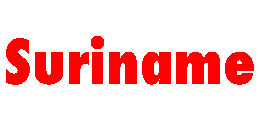
|
February / March 2020 |
Monday 2 March 2020
I go to the main post office at half past seven for a postage stamp. We
traditionally want to send a postcard to the home front. There is a
kiosk in front of the office where I buy a postcard. The post office
opens more than twenty minutes late and turns out to have no change. The
other customers grumble loudly about so much incompetence. I quickly
walk to the Republic Bank a few doors a way
to exchange a 50 SRD (€ 6.20) note. Then back to the post office for the
stamp of 7.2 SRD (€ 0.89). It is not possible to drop it off at the
counter, it has to be dropped into the mailbox. I hope for the best.
[The card arrived in 5 days. Expectations were exceeded by far !!]
way
to exchange a 50 SRD (€ 6.20) note. Then back to the post office for the
stamp of 7.2 SRD (€ 0.89). It is not possible to drop it off at the
counter, it has to be dropped into the mailbox. I hope for the best.
[The card arrived in 5 days. Expectations were exceeded by far !!]
Our rental car is brought to the hotel, as we find out after a phone
call to the rental company Ross. In our booking confirmation it said Van
Sommelsdijkstraat 8, but that turns out to be just a meeting place, not
an office. So why not at the hotel? The half hour wait half becomes 50
minutes. Then it turns out that the boot cover is not in it. We can pick
it up at the rental office at Kwattaweg. Fortunately that is in the
direction of Nieuw Nickerie, where we want to go. There the car no
longer wants to start. The battery has to be replaced. Fortunately, that
is possible immediately. All in all, we don't leave for Nieuw Nickerie
un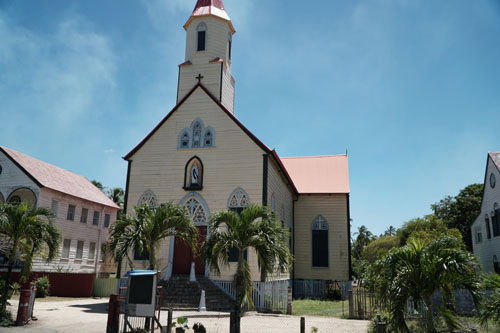 til
half past ten. On the way we stop in Groningen, where we make drone
images of the Saramacca river. Groningen was founded in the mid-19th
century by a group of Dutch Reformed farmers from Groningen and
Gelderland provinces, who wanted to work the land here. Slave plantation
owners didn't think it was such a good idea: agricultural labor was for
black slaves, not white people. The Boeroes, as they were called, met
with a lot of adversity. Half the group succumbed to typhus. Many others
decided to move to Paramaribo. 45 Boeroes remained. The settlement only
started to grow after a road was built to Paramaribo in the 60s of the
20th century. Until then it was only accessible by boat. We eat a
sandwich there. Then we drive on again. We cross the long bridge over
the wide Coppename river. This bridge replaced a ferry connection in
1999. We make a short stop in Totness, the district capital of the
Coronie district. Here is a beautiful wooden church (Mary Immaculate
Conception; late 19th century). Then we drive on to Nieuw Nickerie. It
is still a long drive, with a lot of roadworks and the road has many bad
sections, it must be said.
til
half past ten. On the way we stop in Groningen, where we make drone
images of the Saramacca river. Groningen was founded in the mid-19th
century by a group of Dutch Reformed farmers from Groningen and
Gelderland provinces, who wanted to work the land here. Slave plantation
owners didn't think it was such a good idea: agricultural labor was for
black slaves, not white people. The Boeroes, as they were called, met
with a lot of adversity. Half the group succumbed to typhus. Many others
decided to move to Paramaribo. 45 Boeroes remained. The settlement only
started to grow after a road was built to Paramaribo in the 60s of the
20th century. Until then it was only accessible by boat. We eat a
sandwich there. Then we drive on again. We cross the long bridge over
the wide Coppename river. This bridge replaced a ferry connection in
1999. We make a short stop in Totness, the district capital of the
Coronie district. Here is a beautiful wooden church (Mary Immaculate
Conception; late 19th century). Then we drive on to Nieuw Nickerie. It
is still a long drive, with a lot of roadworks and the road has many bad
sections, it must be said.
We arrive at a quarter to four. The Re sidence
Inn hotel is located in the middle of the village, is a bit
old-fashioned, but otherwise has everything we wish for. I let the drone
up again and take pictures of the town and the Nickerie and Corantijn
rivers. These rivers meet at Nieuw Nickerie and flow into the Ocean. The
Corantijn is also the border river with neighboring country Guyana. We
drink a beer on the terrace of the hotel. In the evening we eat Chinese
at Hong Kong 2 restaurant.
sidence
Inn hotel is located in the middle of the village, is a bit
old-fashioned, but otherwise has everything we wish for. I let the drone
up again and take pictures of the town and the Nickerie and Corantijn
rivers. These rivers meet at Nieuw Nickerie and flow into the Ocean. The
Corantijn is also the border river with neighboring country Guyana. We
drink a beer on the terrace of the hotel. In the evening we eat Chinese
at Hong Kong 2 restaurant.
We watch some TV on the laptop and have a drink in the hotel bar.
Weather: cloudy with sunny spells. 32 degrees.
Tuesday 3 March 2020
We have breakfast early and at 8am. We are picked up at 9am by Albatros
Tou rs
for a tour to Bigi Pan, the large lake in the mangroves near
Nieuw Nickerie. The owner himself picks us up. He is a Javanese rice
farmer. He takes us to the jetty where the boat is ready. His grandson
Miguel is going to guide us around the area. Construction work is going
on around the jetty. A reception and toilet building is being built.
With Miguel we go up a bit on the Nickerie river to a slipway. We have
to get out of the boat for a moment. With a winch, made of a moped
motor, the boat is towed over the slope to the channel that runs towards
the Bigi Pan. The two water systems are separated to prevent salt or
brackish water from flowing from the Nickerie into the Bigi Pan.
Conversely, Bigipan can drain into the Nickerie during high water. We
motor down the canal and see lots of special birds. Especially many
egrets, but also the marsh buzzard and the American Eagle Owl. The red
ibises are very beautiful with their bright red feathers. Also a gray
heron and
rs
for a tour to Bigi Pan, the large lake in the mangroves near
Nieuw Nickerie. The owner himself picks us up. He is a Javanese rice
farmer. He takes us to the jetty where the boat is ready. His grandson
Miguel is going to guide us around the area. Construction work is going
on around the jetty. A reception and toilet building is being built.
With Miguel we go up a bit on the Nickerie river to a slipway. We have
to get out of the boat for a moment. With a winch, made of a moped
motor, the boat is towed over the slope to the channel that runs towards
the Bigi Pan. The two water systems are separated to prevent salt or
brackish water from flowing from the Nickerie into the Bigi Pan.
Conversely, Bigipan can drain into the Nickerie during high water. We
motor down the canal and see lots of special birds. Especially many
egrets, but also the marsh buzzard and the American Eagle Owl. The red
ibises are very beautiful with their bright red feathers. Also a gray
heron and 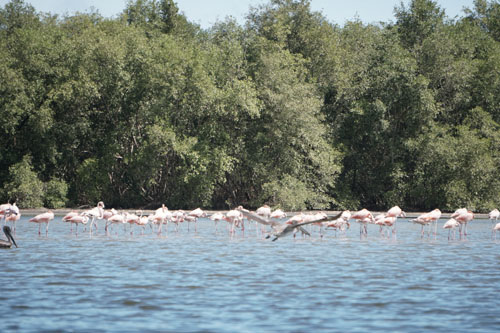 lots
of terns. After an hour we arrive at the Bigi Pan. On the south side of
the lake four houses have been built on the water for the same number of
operators. We get off the boat for a coffee at Albatros' residence.
Miguel tells a lot about the birds and the area. After coffee we move
onto the lake and can view the flamingos and pelicans at a reasonable
distance. The lake has become very shallow due to the drought. Miguel
has follow the fairways carefully to avoid getting stuck. Miguel keeps a
good distance from the birds so that they do not startle and fly away.
On the lake we see mullets, small fish jumping out of the water.
Sometimes they accidentally end up inside the boat and that is
immediately fatal for them. They end up get under the deck, where we can
not reach them and they suffocate there. It happens about four times. We
also see an osprey. We sail back to the house on stilts, where we will
have lunch prepared by Grandma Gerda. It is rice with long beans and
chicken legs. It tastes delicious. After lunch we return back to the
jetty, where grandfather is waiting. He retur
lots
of terns. After an hour we arrive at the Bigi Pan. On the south side of
the lake four houses have been built on the water for the same number of
operators. We get off the boat for a coffee at Albatros' residence.
Miguel tells a lot about the birds and the area. After coffee we move
onto the lake and can view the flamingos and pelicans at a reasonable
distance. The lake has become very shallow due to the drought. Miguel
has follow the fairways carefully to avoid getting stuck. Miguel keeps a
good distance from the birds so that they do not startle and fly away.
On the lake we see mullets, small fish jumping out of the water.
Sometimes they accidentally end up inside the boat and that is
immediately fatal for them. They end up get under the deck, where we can
not reach them and they suffocate there. It happens about four times. We
also see an osprey. We sail back to the house on stilts, where we will
have lunch prepared by Grandma Gerda. It is rice with long beans and
chicken legs. It tastes delicious. After lunch we return back to the
jetty, where grandfather is waiting. He retur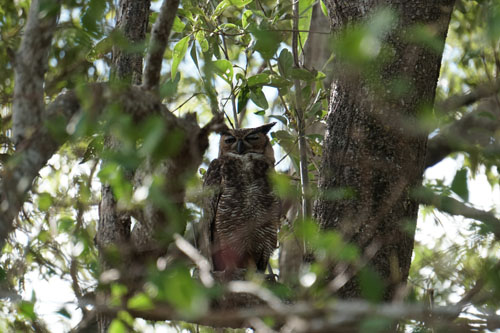 ns
us to the hotel at 1 pm, where we pick up our luggage .
ns
us to the hotel at 1 pm, where we pick up our luggage .
Then we immediately leave for Paramaribo. We fill up the tank in Nieuw
Nickerie and then we drive the long way back to Paramaribo. Especially
in the beginning the road has bad stretches and the road is being worked
on. After Wageningen, the road improves and we can continue driving at a
comfortable speed. In Paramaribo it is busy on the road and we get into
a traffic jam. We arrivee in Kekemba resort around 17.10. We are
welcomed by host Lloyd Vrij. We get apartment No. 1. It is large and
well furnished. It is not directly at the pool, which is all the more
quiet.
Weather: sunny 32 degrees.
Wednesday 4 March 2020
When we wake up there appears to be a power failure. No light, no water pressure. We have breakfast with
our groceries bought last night and then head towards the Jules
Wijdenbosch Bridge over the Suriname River. We drive to Fort
Nieuw-Amsterdam. This fort was established in the 16th century as a
defense of the estuary of the Suriname and the Commewijne rivers and the
plantations that were located upstream. Construction was not easy. The
soil turned out to be unsuitable for baking stones and the soil was too
soft to build a heavy fortress. Hence only an earthen wall was erected
with cannons on it. Nevertheless, the English could easily occupy the
fortress in 1799 and 1804, without firing a shot. After the restoration of
Dutch authority in 1814 it became a prison. The soldiers left. After that
it became the center of the district administration in 1905. The earthen
wall, the moat and the cannons are still there, as is the prison and the
powder house. In the prison is an exhibition about the different
population groups of Suriname and the history of the
to be a power failure. No light, no water pressure. We have breakfast with
our groceries bought last night and then head towards the Jules
Wijdenbosch Bridge over the Suriname River. We drive to Fort
Nieuw-Amsterdam. This fort was established in the 16th century as a
defense of the estuary of the Suriname and the Commewijne rivers and the
plantations that were located upstream. Construction was not easy. The
soil turned out to be unsuitable for baking stones and the soil was too
soft to build a heavy fortress. Hence only an earthen wall was erected
with cannons on it. Nevertheless, the English could easily occupy the
fortress in 1799 and 1804, without firing a shot. After the restoration of
Dutch authority in 1814 it became a prison. The soldiers left. After that
it became the center of the district administration in 1905. The earthen
wall, the moat and the cannons are still there, as is the prison and the
powder house. In the prison is an exhibition about the different
population groups of Suriname and the history of the 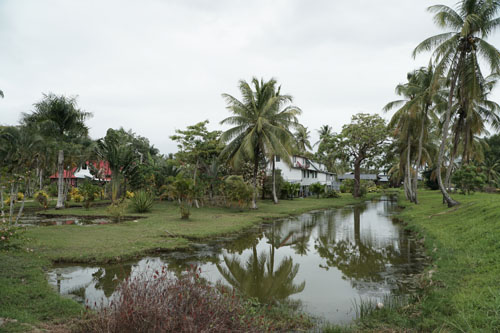 fortress.
There is a poor museum café, where we drink a cup of instant coffee .
fortress.
There is a poor museum café, where we drink a cup of instant coffee .We then drive on to Marienburg, where we take a taxi boat across the Commewijne to Frederiksdorp, a former plantation. It is now a hotel with rooms in the former homes of the plantation owner and his foremen. There is also a nice restaurant where we have lunch. Many beautiful birds can be seen near the hotel. During lunch we get two heavy rain showers, but luckily we are dry under large umbrellas.
After lunch we sail back to Marienburg and continue via Alkmaar to the Katwijk plantation. It is the only working coffee plantation left in Suriname. The plantation was founded in 1746. Although the official tours are at 10 and 12 o'clock we still get a tour of the plantation. Coffee production is modest. That is why they also grow oranges and limes. We drive into both the coffee field and the citrus field. After the tour we get a cup of coffee from their own soil.
Then we drive back to Para
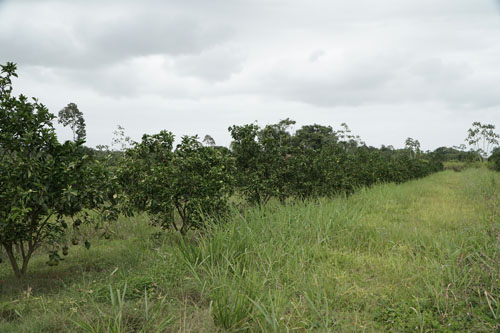 maribo.
There is a long traffic jam in front of the bridge. This is partly due to
rush hour, but also due to the steep slope of the bridge, which means that
trucks can only drive upwards at a walking pace.
maribo.
There is a long traffic jam in front of the bridge. This is partly due to
rush hour, but also due to the steep slope of the bridge, which means that
trucks can only drive upwards at a walking pace.In the evening we eat in the district Blauwgrond at a Javanese eatery called Lola. We eat delicious Indonesian dishes at very modest prices. We ate and drank for 115 SRD (€ 14.30).
After that we drink coffee at Torarica and head back to the resort.
Weather: cloudy, rain showers. 26 degrees
Thursday 5 March 2020
We rijden via de Martin Luther Kingweg richting het zuiden naar Berg en Dal. In de stad is het erg druk op de weg, maar eenmaal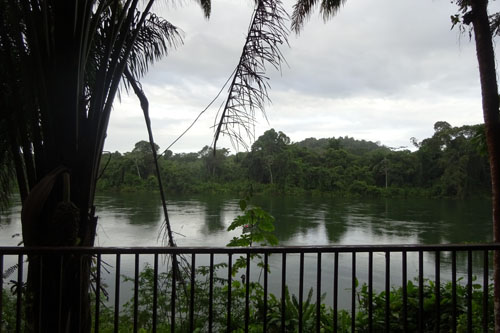 buiten de stad wordt het rustiger en kunnen we goed doorrijden. De weg is
in uitstekende staat. Rond 11 uur zijn we bij Berg en Dal en gaan we de
hoofdweg af. We rijden over een onverhard, bochtig weggetje naar het
resort. We geven onze bagage af en checken in, maar kunnen nog niet op de
kamer. Dat kan pas vanaf 14 uur. Berg en Dal is een van de grootste
plantages in Suriname. De plantage werd gestart door gouverneur Temming in
1722, als een particuliere ondernemening, los van de Societeit van
Suriname, die de kolonie als geheel bestuurde. In 1744 verhuisde zijn
dochter en erfgenaam naar Amsterdam. Kort na de afschaffing van de
slavernij in 1863 - de plantage had 315 slaven - werd de plantage verkocht
aan Kersten & Co een firma van een vooraanstaand lid van de Hernhuter
Broedergemeente. De Hernhuters besloten er een zendingspost van te maken.
De zending had veel te leiden van malaria en werd opgegeven. De plantage
bleef in handen van Kersten en werd in 1968 bereikbaar over de weg. Toen
begon de leegloop van het dorp naar de grote stad. Tijdens de binnenlandse
oorlog van 1986 tot 1992 was het dorp geheel onbewoond. Vanaf 2003 begon
Kersten met de ontwikkeling van een eco resort. In 2008
buiten de stad wordt het rustiger en kunnen we goed doorrijden. De weg is
in uitstekende staat. Rond 11 uur zijn we bij Berg en Dal en gaan we de
hoofdweg af. We rijden over een onverhard, bochtig weggetje naar het
resort. We geven onze bagage af en checken in, maar kunnen nog niet op de
kamer. Dat kan pas vanaf 14 uur. Berg en Dal is een van de grootste
plantages in Suriname. De plantage werd gestart door gouverneur Temming in
1722, als een particuliere ondernemening, los van de Societeit van
Suriname, die de kolonie als geheel bestuurde. In 1744 verhuisde zijn
dochter en erfgenaam naar Amsterdam. Kort na de afschaffing van de
slavernij in 1863 - de plantage had 315 slaven - werd de plantage verkocht
aan Kersten & Co een firma van een vooraanstaand lid van de Hernhuter
Broedergemeente. De Hernhuters besloten er een zendingspost van te maken.
De zending had veel te leiden van malaria en werd opgegeven. De plantage
bleef in handen van Kersten en werd in 1968 bereikbaar over de weg. Toen
begon de leegloop van het dorp naar de grote stad. Tijdens de binnenlandse
oorlog van 1986 tot 1992 was het dorp geheel onbewoond. Vanaf 2003 begon
Kersten met de ontwikkeling van een eco resort. In 2008 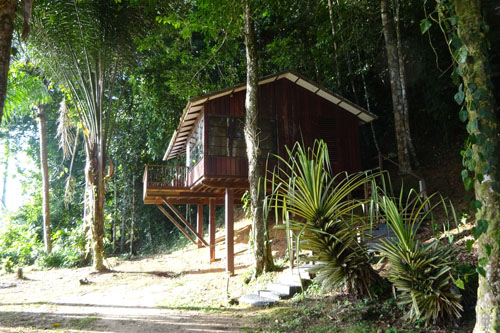 werd
het officieel geopend.
werd
het officieel geopend. We gaan verder met de auto naar het natuurpark Brownsberg, althans dat is de bedoeling. Maar de weg vanaf het dorp Brownsweg naar het natuurreservaat is zo slecht dat we het niet aandurven door te rijden. We keren om en gaan in plaats daarvan de stuwdam en het stuwmeer bekijken bij Afobakka. De dam is tussen 1958 en 1965 aangelegd om Suriname en vooral de Suralco, met zijn aluminumsmelter van energie te voorzien. Vele marrondorpen zijn daarvoor onderwater gezet door het ontstaan van het stuwmeer, het Dr Van Blommesteijnmeer. De bewoners werden verplaatst naar nieuwe dorpen, stroomafwaarts. Verder is er niet zoveel te beleven. We rijden terug naar Berg en Dal, waar we moeten wachten tot 14 uur precies, voor we de sleutel krijgen. We hebben een prachtig huisje op een verhoging met zicht op de Surinamerivier, helemaal aan het eind van het resort. Een rustige plek, met een prachtig uitzicht vanaf ons ruime balkon. Ook vanuit ons bed hebben we mooi zicht op de rivier.
’s Middags gaan we nog even zwemmen in het zwembad en drinken we een drankje aan de bar, eveneens aan de rivieroever. ’s Avond dineren we op het resort. We nemen het buffetdiner, dat redelijk goed smaakt. Na het eten luisteren we op ons balkon naar de geluiden van het oerwoud. Daarbij zijn vooral de kikkers goed hoorbaar. Na een paar uur kalmeren ze een beetje en horen we ook andere dieren, zoals krekels, cicaden en apen.
Weer: bewolkt met zo nu en dan een bui. 26 graden
Friday 6 March 2020
We have breakfast around 7am. After brea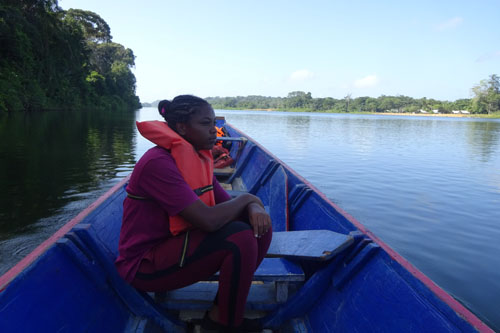 kfast
we have plenty of time to pack our suitcases and wait for the departure of
the Boat trip at 9 am. With a guide we make a trip on the Suriname River,
along an island in the river and some Maroon villages. We do not see many
animals, but we do see many types of trees and plants.
kfast
we have plenty of time to pack our suitcases and wait for the departure of
the Boat trip at 9 am. With a guide we make a trip on the Suriname River,
along an island in the river and some Maroon villages. We do not see many
animals, but we do see many types of trees and plants.Back in our cabin we call the reception that they can collect our suitcases. We walk to the reception ourselves and pay the bill. Then just wait for the suitcases to arrive. Next we drive to Paramaribo.
The trip goes smoothly until we get into the city and we get stuck in traffic. Finally we reach the Krasnapolsky hotel at Domineestraat around 12.30. We can't get into the room until 3pm, so we need to kill some time. We first have lunch in the restaurant on the 3rd floor. The food is fine, but the service is very slow. Although we are the only guests, it takes 45 minutes before we have food on the table. Then we walk around the center and have a drink on a side walk bar. Then we can finally enter the room. It is fine. Only
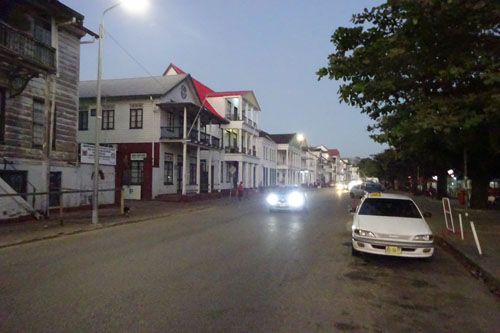 closing the room door is a bit weird.
closing the room door is a bit weird.Around five o'clock we go to a cocktail bar and then we eat at E'tembe, a restaurant on the waterfront where they serve Marron dishes. I eat caiman on a skewer and Erik moksi alesi with chicken. Erik also takes a special smoothie made from Awarra.
We walk back to the hotel, watch football on the computer and then have a drink at the hotel bar.
Weather: cloudy, 31 degrees.ontbijten rond 7 uur.
Saturday 7 March 2020
After breakfast we wait for my relatives Rieke and Zahira. We are going to have coffee with them at Coffee Box somewhere in the suburbs of the city. It is cozy and we exchange all kinds of family tales while enjoying a coffee and a cake. Time flies and around half past one we go back to the hotel.We rest a bit in the room and around 4 pm we go to the airport. We fill up on the way. We take the highway towards Paranam - not the busy and slow road through Lelydorp - and then turn right to Zanderij.
At the airport, we hand over the car to the Ross Car Rental representative and join the queue for check-in. That takes a while and then on to the security check. Then the waiting begins.
The plane leaves reasonably on time at 19.15 to Amsterdam. The flight goes without problems and we are in Amsterdam before 8am.
The Intercity Direct to Rotterdam is not long in coming and the Uber taxi in Rotterdam meets us within a minute. We are home at 10 am.
